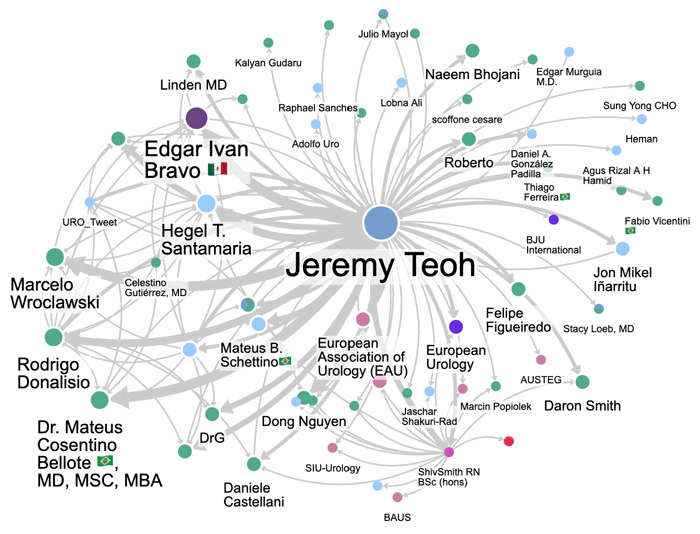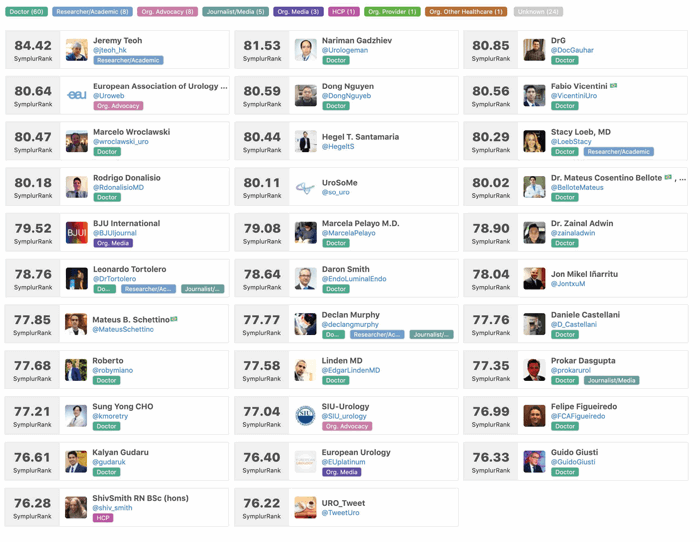
In recent years, the digitisation of scientific information has been astonishing and the use of social networks has been increasing worldwide. Social networks play a fundamental role in the dissemination of information and scientific knowledge in the field of urology [1,2].
Social networking platforms enhance and facilitate our ability to share information, discuss clinical cases, and connect and interact with people from all around the world. While we see the potential impact of social media in the field of urology, we believe that it should be used in a proper and appropriate manner [3]. Sharing of true and authentic scientific information, ensuring patient’s privacy and the openness towards different opinions form the basis of meaningful and constructive conversations among the urological community.

Figure 1.
What is the #UroSoMe initiative?
The beginning of #UroSoMe project has to do with Jeremy Teoh’s (@jteoh_hk) impression in August 2018 when he was surprised by the active engagement of #SoMe4Surgery participants on Twitter [4]. He had participated in a live discussion on #surgicalinfection and suddenly realised how the use of a simple hashtag could bring the surgical community together. However, he felt that the topics discussed were not entirely relevant to urologists. He started to conceptualise the hashtag, #UroSoMe, and registered the Twitter account in August 2018. His main goals were to develop an online urology community linked by a hashtag specific to urology, with the intent of increasing public awareness about urological diseases and to engage the urology community through this social media platform. After an invited talk about social media at the 27th Malaysian Urological Conference, he decided to carry on with this project and sent an official public invitation in Twitter on 14 December 2018 for people to join this community [4]. This day is considered the birth date of the #UroSoMe community.
#UroSoMe in numbers
On 9 April 2019, we performed a search in Symplur (www.symplur.com/), a social media analytics platform for healthcare. This search included data from 15 December 2018 to 8 April 2019. During this time period, the hashtag, #UroSoMe, was used a total of 14,883 times. A total of 10,079 retweets has been recorded. The #UroSoMe community is still expanding, and up until 8 April 2019, a total of 2262 Twitter users has been using this hashtag. These numbers have yielded a total of 21,178,622 impressions. Most discussions were initiated by Jeremy (@jteoh_hk) and the #UroSoMe working group as shown in the network analysis in Figure 1. The top influencers are shown in Figure 2. Recently, #UroSoMe had the greatest honour to receive the Innovation Award at the 7th BJUI Social Media Awards (2019), which took place in Barcelona during the 34th Annual European Association of Urology Congress [5].

Figure 2.
#UroSoMe live events
#UroSoMe aims to engage all stakeholders in the field of urology. Anybody who is interested in a urological topic will be able to identify relevant content in Twitter via a simple hashtag. In order to disseminate knowledge effectively and to encourage discussions and interactions among the urological community, the #UroSoMe working group regularly conducts live events that help connect individuals and intensify the exchange of conversations. We have conducted three live events so far, including #LiveCaseDiscussions on ‘Stone’, #LiveForum on ‘BPH Surgery’ and #LiveJournalClub on ‘Bladder Cancer Research Priorities’. After each live event, twitter data is collected and analysed by the working group to demonstrate the importance and influence of #UroSoMe in a scientific manner.
Future directions
#UroSoMe is an expanding urological community that has been built with the intent to disseminate, share and integrate knowledge with scientific and academics discussions among the urological community. Future directions should be to continue regular online events to increase participation and engagement from the urological community, and to include doctors from other specialities, other healthcare professionals, patients and the general public. We believe that #UroSoMe will continue to grow, and we hope our patients can ultimately benefit from the integration and growth of this community.
TAKE HOME MESSAGE
-
Social media is easy to learn and this platform allows rapid knowledge transfer in an interactive manner.
-
The #UroSoMe working group conducts regular live events to promote participation and engagement from the urological community.
-
#UroSoMe allows us to learn from each other through interactive, meaningful and constructive conversations.
-
There is no restriction within the #UroSoMe community. Whoever and wherever you are, we welcome you to join us.
-
Only with your help can the #UroSoMe community continue to grow. Do not hesitate and start by using the hashtag, #UroSoMe!
References
1.Sternberg KM, Loeb SL, Canes D, et al. The use of Twitter to facilitate sharing of clinical expertise in urology. J Am Med Informatics Assoc 2018;25:183-6.
2. Bayne CE, Murphy DG, Loeb S. #Urology is trending in social media. Rev Urol 2014;16:152-4.
3. Borgmann H, Cooperberg M, Murphy D, et al. Online Professionalism—2018 Update of European Association of Urology (@Uroweb) Recommendations on the Appropriate Use of Social Media. Eur Urol 2018;74:644-50.
4. Teoh J. The beginning of #UroSoMe. BJUI.
www.bjuinternational.com/
bjui-blog/blog-the-beginning-of-urosome/
Accessed 22 February 2019.
5. Murphy D. The 7th BJUI Social Media Awards (2019).
www.bjuinternational.com/
bjui-blog/7th-bjui-social-media-awards-2019/
Accessed 11 April 2019.



